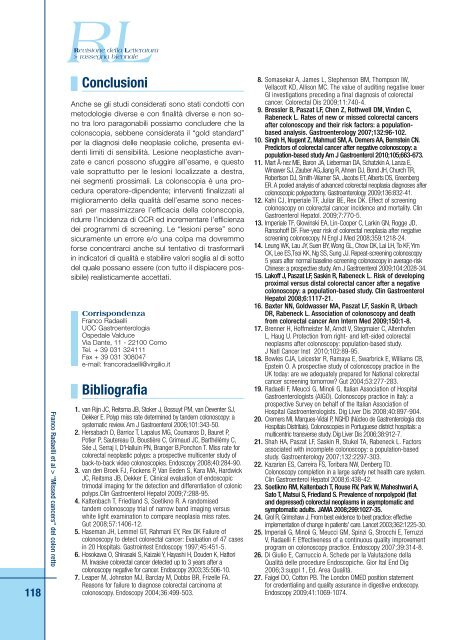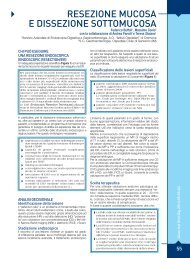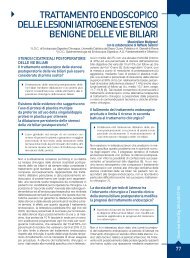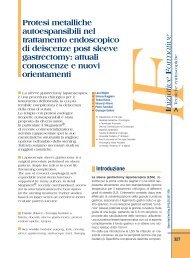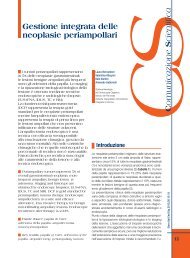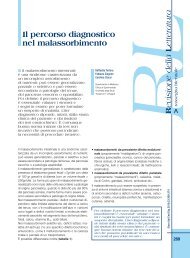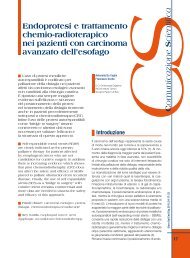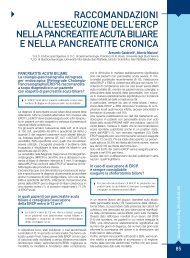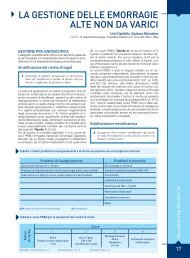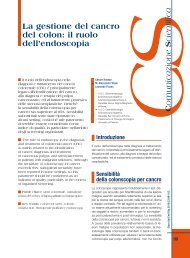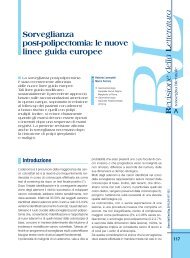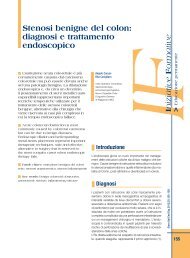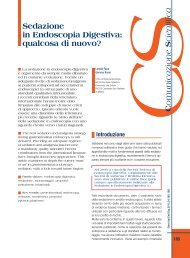Il problema dei "missed cancers" del colon-retto - Sied
Il problema dei "missed cancers" del colon-retto - Sied
Il problema dei "missed cancers" del colon-retto - Sied
- No tags were found...
Create successful ePaper yourself
Turn your PDF publications into a flip-book with our unique Google optimized e-Paper software.
118Franco Radaelli et al > "Missed cancers" <strong>del</strong> <strong>colon</strong> <strong>retto</strong>LRevisione <strong>del</strong>la Letteratura> rassegna biennaleConclusioniAnche se gli studi considerati sono stati condotti conmetodologie diverse e con finalità diverse e non sonotra loro paragonabili possiamo concludere che la<strong>colon</strong>scopia, sebbene considerata il “gold standard”per la diagnosi <strong>del</strong>le neoplasie coliche, presenta evidentilimiti di sensibilità. Lesione neoplastiche avanzatee cancri possono sfuggire all’esame, e questovale soprattutto per le lesioni localizzate a destra,nei segmenti prossimali. La <strong>colon</strong>scopia è una proceduraoperatore-dipendente; interventi finalizzati almiglioramento <strong>del</strong>la qualità <strong>del</strong>l’esame sono necessariper massimizzare l’efficacia <strong>del</strong>la <strong>colon</strong>scopia,ridurre l’incidenza di CCR ed incrementare l’efficienza<strong>dei</strong> programmi di screening. Le “lesioni perse” sonosicuramente un errore e/o una colpa ma dovremmoforse concentrarci anche sul tentativo di trasformarliin indicatori di qualità e stabilire valori soglia al di sotto<strong>del</strong> quale possano essere (con tutto il dispiacere possibile)realisticamente accettati.CorrispondenzaFranco RadaelliUOC GastroenterologiaOspedale ValduceVia Dante, 11 - 22100 ComoTel. + 39 031 324111Fax + 39 031 308047e-mail: francoradaelli@virgilio.itBibliografia1. van Rijn JC, Reitsma JB, Stoker J, Bossuyt PM, van Deventer SJ,Dekker E. Polyp miss rate determined by tandem <strong>colon</strong>oscopy: asystematic review. Am J Gastroenterol 2006;101:343-50.2. Hersabach D, Barrioz T, Lapalus MG, Coumaros D, Bauret P,Potier P, Sautereau D, Boustière C, Grimaud JC, Barthélémy C,Sée J, Serraj I, D'Halluin PN, Branger B,Ponchon T. Miss rate forcolorectal neoplastic polyps: a prospective multicenter study ofback-to-back video <strong>colon</strong>oscopies. Endoscopy 2008;40:284-90.3. van den Broek FJ, Fockens P, Van Eeden S, Kara MA, HardwickJC, Reitsma JB, Dekker E. Clinical evaluation of endoscopictrimodal imaging for the detection and differentiation of <strong>colon</strong>icpolyps.Clin Gastroenterol Hepatol 2009;7:288-95.4. Kaltenbach T, Friedland S, Soetikno R. A randomisedtandem <strong>colon</strong>oscopy trial of narrow band imaging versuswhite light examination to compare neoplasia miss rates.Gut 2008;57:1406-12.5. Haseman JH, Lemmel GT, Rahmani EY, Rex DK Failure of<strong>colon</strong>oscopy to detect colorectal cancer: Evaluation of 47 casesin 20 Hospitals. Gastrointest Endoscopy 1997;45:451-5.6. Hosokawa O, Shirasaki S, Kaizaki Y, Hayashi H, Douden K, HattoriM. Invasive colorectal cancer detected up to 3 years after a<strong>colon</strong>oscopy negative for cancer. Endoscopy 2003;35:506-10.7. Leaper M, Johnston MJ, Barclay M, Dobbs BR, Frizelle FA.Reasons for failure to diagnose colorectal carcinoma at<strong>colon</strong>oscopy. Endoscopy 2004;36:499-503.8. Somasekar A, James L, Stephenson BM, Thompson IW,Vellacott KD, Allison MC. The value of auditing negative lowerGI investigations preceding a final diagnosis of colorectalcancer. Colorectal Dis 2009;11:740-4.9. Bressler B, Paszat LF, Chen Z, Rothwell DM, Vinden C,Rabeneck L. Rates of new or <strong>missed</strong> colorectal cancersafter <strong>colon</strong>oscopy and their risk factors: a populationbasedanalysis. Gastroenterology 2007;132:96-102.10. Singh H, Nugent Z, Mahmud SM, A. Demers AA, Bernstein CN.Predictors of colorectal cancer after negative <strong>colon</strong>oscopy: apopulation-based study Am J Gastroenterol 2010;105;663-673.11. Mart Ã-nez ME, Baron JA, Lieberman DA, Schatzkin A, Lanza E,Winawer SJ, Zauber AG,Jiang R, Ahnen DJ, Bond JH, Church TR,Robertson DJ, Smith-Warner SA, Jacobs ET, Alberts DS, GreenbergER. A pooled analysis of advanced colorectal neoplasia diagnoses after<strong>colon</strong>oscopic polypectomy. Gastroenterology 2009;136:832-41.12. Kahi CJ, Imperiale TF, Juliar BE, Rex DK. Effect of screening<strong>colon</strong>oscopy on colorectal cancer incidence and mortality. ClinGastroenterol Hepatol. 2009;7:770-5.13. Imperiale TF, Glowinski EA, Lin-Cooper C, Larkin GN, Rogge JD,Ransohoff DF. Five-year risk of colorectal neoplasia after negativescreening <strong>colon</strong>oscopy. N Engl J Med 2008;359:1218-24.14. Leung WK, Lau JY, Suen BY, Wong GL, Chow DK, Lai LH, To KF, YimCK, Lee ES,Tsoi KK, Ng SS, Sung JJ. Repeat-screening <strong>colon</strong>oscopy5 years after normal baseline-screening <strong>colon</strong>oscopy in average-riskChinese: a prospective study. Am J Gastroenterol 2009;104:2028-34.15. Lakoff J, Paszat LF, Saskin R, Rabeneck L. Risk of developingproximal versus distal colorectal cancer after a negative<strong>colon</strong>oscopy: a population-based study. Clin GastroenterolHepatol 2008;6:1117-21.16. Baxter NN, Goldwasser MA, Paszat LF, Saskin R, UrbachDR, Rabeneck L. Association of <strong>colon</strong>oscopy and deathfrom colorectal cancer Ann Intern Med 2009;150:1-8.17. Brenner H, Hoffmeister M, Arndt V, Stegmaier C, AltenhofenL, Haug U. Protection from right- and left-sided colorectalneoplasms after <strong>colon</strong>oscopy: population-based study.J Natl Cancer Inst 2010;102:89-95.18. Bowles CJA, Leicester R, Ramaya E, Swarbrick E, Williams CB,Epstein O. A prospective study of <strong>colon</strong>oscopy practice in theUK today: are we adequately prepared for National colorectalcancer screening tomorrow? Gut 2004;53:277-283.19. Radaelli F, Meucci G, Minoli G, Italian Association of HospitalGastroenterologists (AIGO). Colonoscopy practice in Italy: aprospective Survey on behalf of the Italian Association ofHospital Gastroenterologists. Dig Liver Dis 2008;40:897-904.20. Cremers MI, Marques-Vidal P, NGHD (Núcleo de Gastrenterologia dosHospitais Distritais). Colonoscopies in Portuguese district hospitals: amulticentric transverse study. Dig Liver Dis 2006;38:912-7.21. Shah HA, Paszat LF, Saskin R, Stukel TA, Rabeneck L. Factorsassociated with incomplete <strong>colon</strong>oscopy: a population-basedstudy. Gastroenterology 2007;132:2297-303.22. Kazarian ES, Carreira FS, Toribara NW, Denberg TD.Colonoscopy completion in a large safety net health care system.Clin Gastroenterol Hepatol 2008;6:438-42.23. Soetikno RM, Kaltenbach T, Rouse RV, Park W, Maheshwari A,Sato T, Matsui S, Friedland S. Prevalence of nonpolypoid (flatand depressed) colorectal neoplasms in asymptomatic andsymptomatic adults. JAMA 2008;299:1027-35.24. Grol R, Grimshaw J. From best evidence to best practice: effectiveimplementation of change in patients' care. Lancet 2003;362:1225-30.25. Imperiali G, Minoli G, Meucci GM, Spinzi G, Strocchi E, TerruzziV, Radaelli F. Effectiveness of a continuous quality improvementprogram on <strong>colon</strong>oscopy practice. Endoscopy 2007;39:314-8.26. Di Giulio E, Carnuccio A. Schede per la Valutazione <strong>del</strong>laQualità <strong>del</strong>le procedure Endoscopiche. Gior Ital End Dig2006;3:suppl 1, Ed. Area Qualità.27. Faigel DO, Cotton PB. The London OMED position statementfor credentialing and quality assurance in digestive endoscopy.Endoscopy 2009;41:1069-1074.


